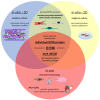Extracellular Matrix-Based Approaches in Cardiac Regeneration: Challenges and Opportunities
- PMID: 36555424
- PMCID: PMC9779713
- DOI: 10.3390/ijms232415783
Extracellular Matrix-Based Approaches in Cardiac Regeneration: Challenges and Opportunities
Abstract
Cardiac development is characterized by the active proliferation of different cardiac cell types, in particular cardiomyocytes and endothelial cells, that eventually build the beating heart. In mammals, these cells lose their regenerative potential early after birth, representing a major obstacle to our current capacity to restore the myocardial structure and function after an injury. Increasing evidence indicates that the cardiac extracellular matrix (ECM) actively regulates and orchestrates the proliferation, differentiation, and migration of cardiac cells within the heart, and that any change in either the composition of the ECM or its mechanical properties ultimately affect the behavior of these cells throughout one's life. Thus, understanding the role of ECMs' proteins and related signaling pathways on cardiac cell proliferation is essential to develop effective strategies fostering the regeneration of a damaged heart. This review provides an overview of the components of the ECM and its mechanical properties, whose function in cardiac regeneration has been elucidated, with a major focus on the strengths and weaknesses of the experimental models so far exploited to demonstrate the actual pro-regenerative capacity of the components of the ECM and to translate this knowledge into new therapies.
Keywords: cardiac regeneration; extracellular matrix; mechanobiology.
Conflict of interest statement
The authors declare no conflict of interest.
Figures
Similar articles
-
Decellularized zebrafish cardiac extracellular matrix induces mammalian heart regeneration.Sci Adv. 2016 Nov 18;2(11):e1600844. doi: 10.1126/sciadv.1600844. eCollection 2016 Nov. Sci Adv. 2016. PMID: 28138518 Free PMC article.
-
A dynamic spatiotemporal extracellular matrix facilitates epicardial-mediated vertebrate heart regeneration.Dev Biol. 2013 Oct 15;382(2):457-69. doi: 10.1016/j.ydbio.2013.08.002. Epub 2013 Aug 11. Dev Biol. 2013. PMID: 23939298 Free PMC article.
-
The extracellular matrix in myocardial injury, repair, and remodeling.J Clin Invest. 2017 May 1;127(5):1600-1612. doi: 10.1172/JCI87491. Epub 2017 May 1. J Clin Invest. 2017. PMID: 28459429 Free PMC article. Review.
-
The ECM as a driver of heart development and repair.Development. 2021 Mar 5;148(5):dev191320. doi: 10.1242/dev.191320. Development. 2021. PMID: 33674261 Review.
-
Reconstitution of the myocardium in regenerating newt hearts is preceded by transient deposition of extracellular matrix components.Stem Cells Dev. 2013 Jul 1;22(13):1921-31. doi: 10.1089/scd.2012.0575. Epub 2013 Apr 5. Stem Cells Dev. 2013. PMID: 23398466 Free PMC article.
Cited by
-
Evaluation of Bayesian Linear Regression derived gene set test methods.BMC Genomics. 2024 Dec 23;25(1):1236. doi: 10.1186/s12864-024-11026-2. BMC Genomics. 2024. PMID: 39716056 Free PMC article.
-
Living Nanofiber-Enabled Cardiac Patches for Myocardial Injury.JACC Basic Transl Sci. 2025 Feb;10(2):227-240. doi: 10.1016/j.jacbts.2024.06.010. Epub 2024 Sep 4. JACC Basic Transl Sci. 2025. PMID: 40131159 Free PMC article. Review.
-
Lab-grown, 3D extracellular matrix particles improve cardiac function and morphology in myocardial ischemia.Am J Physiol Heart Circ Physiol. 2025 Feb 1;328(2):H221-H234. doi: 10.1152/ajpheart.00581.2024. Epub 2024 Dec 20. Am J Physiol Heart Circ Physiol. 2025. PMID: 39705507 Free PMC article.
-
Paintable Decellularized-ECM Hydrogel for Preventing Cardiac Tissue Damage.Adv Sci (Weinh). 2024 Jun;11(21):e2307353. doi: 10.1002/advs.202307353. Epub 2024 Mar 19. Adv Sci (Weinh). 2024. PMID: 38502886 Free PMC article.
-
Developments in Extracellular Matrix-Based Angiogenesis Therapy for Ischemic Heart Disease: A Review of Current Strategies, Methodologies and Future Directions.BioTech (Basel). 2025 Mar 19;14(1):23. doi: 10.3390/biotech14010023. BioTech (Basel). 2025. PMID: 40227326 Free PMC article. Review.
References
Publication types
MeSH terms
Substances
LinkOut - more resources
Full Text Sources


